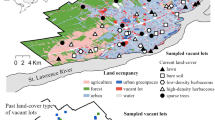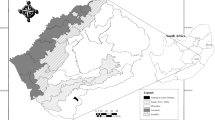Abstract
This study investigated vegetation and soil properties in a beaver-created freshwater wetland located on the Coastal Plain of Virginia near Washington, DC. We focused on the associations among floristic quality, soil physicochemistry, denitrification, and hydrologic conditions of the wetland to understand links between the effects of beaver engineering and ecosystem function. The floristic quality assessment index (FQI) and denitrification are two important indicators often used to examine overall habitat quality and ecosystem functioning of a wetland. Samples were collected from ten plots (10 m × 10 m each) in August 2014. Vegetation attributes included total percent cover, species richness (S), diversity, FQI, and prevalence index (PI). Soil attributes included organic matter (OM), total carbon, total nitrogen, gravimetric moisture (GM), pH, bulk density (Db), and denitrification potential (DP). FQI was greater in the higher of the two standing water level categories, where Db was lower, and was negatively associated with Db but no other soil nutrient properties. DP was positively associated with soil nutrients, OM, and GM, but not with measured vegetation attributes nor standing water levels. We found higher soil GM, lower plant community PI, and lower plot S in this study compared to our previous study, with no changes to other vegetation or soil attributes, indicating enduring beaver activity and a resilient plant community. The outcome of the study includes regression models that best explain the association between structural and functional attributes of the ecosystem, which can be applicable to the study of other beaver-created wetlands. The study also provides partial evidence for the notion that low-lying areas dug out by beaver positively impact the FQI of wetlands.

Similar content being viewed by others
References
Andreas BK, Mack JJ, McCormac JS (2004) Floristic quality assessment index (FQAI) for vascular plants and mosses for the state of Ohio. Division of Surface Water, Wetland Ecology Group, Ohio Environmental Protection Agency, Columbus
Ballantine K, Schneider R, Groffman P, Lehman J (2012) Soil properties and vegetative development in four restored freshwater depressional wetlands. J Soil Sci 76:1482–1495
Booth MS, Stark JM, Rastetter E (2005) Controls on nitrogen cycling in terrestrial ecosystems: a synthetic analysis of literature data. Ecol Monogr 75:139–157
Bouchard V, Frey SD, Gilbert JM, Reed SE (2007) Effects of macrophyte functional group richness on emergent freshwater wetland functions. Ecol 88:2903–2914
Bried JT, Jog SK, Matthews JW (2013) Floristic quality assessment signals human disturbance over natural variability in a wetland system. Ecol Indic 34:260–267
Burgin AJ, Groffman PM, Lewis DN (2010) Factors regulating denitrification in a riparian wetland. Soil Sci Soc Am J 74:1826–1833
Burns DA, McDonnell JJ (1998) Effects of a beaver pond on runoff processes: comparison of two headwater catchments. J Hydrol 205:248–264
Cronk JK, Fennessy MS (2001) Wetland plants: biology and ecology. CRC, Boca Raton, pp 191–227
Davis DL, Harold CM (2006) Determining coefficient of conservatism values (C-values) for vascular plants frequently encountered in tidal and non-tidal wetlands in Virginia. Virginia Department of Environmental Quality, Office of Wetlands and Water Quality, Richmond
Dee SM, Ahn C (2012) Soil properties predict plant community development of mitigation wetlands created in the Virginia Piedmont, USA. Environ Manage 49:1022–1036
Dee SM, Ahn C (2014) Plant tissue nutrients as a descriptor of plant productivity of created mitigation wetlands. Ecol Indic 45:68–74
Fairfax County Park Authority (2017) Huntley meadows park wetland restoration project. IOP,Fairfax County Web. http://www.fairfaxcounty.gov/parks/huntley-meadows-park/restorationproject.htm. Accessed 6 June 2017
Fennessy S (1998) Testing the floristic quality assessment index as an indicator of riparian wetland disturbance. Ohio Environmental Protection Agency technical bulletin. Division of Surface Water, Wetlands Ecology Unit, Columbus
Groffman PM (1994) Denitrification in freshwater wetlands. Curr Top Wetl Biogeochem 1:15–35
Groffman P (1999) Carbon additions increase nitrogen availability in northern hardwood forest soils. Biol Fertil Soils 4:430–433
Groffman P, Hanson G, Kiviat E, Stevens G (1996) Variation in microbial biomass and activity in four different wetland types. Soil Sci Soc Am J 60:622–629
Heffernan K, Engle E, Richardson C (2014) Virginia invasive plant species list. Natural Heritage technical document 14-11. Virginia Department of Conservation and Recreation, Division of Natural Heritage, Richmond
Hill AR, Cardaci M (2004) Denitrification and organic carbon availability in riparian wetland soils and subsurface sediments. J Soil Sci 68:320–325
Hood GA, Larsen DG (2015) Ecological engineering and aquatic connectivity: a new perspective from beaver-modified wetlands. Freshwater Biol 60:198–208
Hopfensperger KN, Kaushal SS, Findlay SEG, Cornwell JC (2009) Influence of plant communities on denitrification in a tidal freshwater marsh of the Potomac River, United States. J Environ Qual 38:618–626
Hudon C (2004) Shift in wetland plant composition and biomass following low-level episodes in the St. Lawrence River: looking into the future. Can J Fish Aquat Sci 61:603–617
Hunter RG, Faulkner SP (2001) Denitrification potentials in restored and natural bottomland hardwood wetlands. J Soil Sci 65:1865–1872
Jordan TE, Andrews MP, Szuch RP, Whigman DF, Weller DE, Jacobs AD (2007) Comparing functional assessments of wetlands to measurements of soil characteristics and nitrogen processing. Wetlands 27:479–497
Lopez RD, Fennessy MS (2002) Testing the floristic quality assessment index as an indicator of wetland condition. Ecol Appl 12:487–497
Meentemeyer RK, Butler DR (1999) Hydrogeomorphic effects of beaver dams in Glacier National Park, Montana. Phys Geogr 20:436–446
Mertler CA, Vannatta RA (2010) Advanced and multivariate statistical methods, 4th edn. Pyrczak, Glendale, pp 25–288
Mitchell CC, Niering WA (1993) Vegetation change in a topogenic bog following beaver flooding. B Torrey Bot Club 120:136–147
Mitsch WJ, Gosselink JG (2007) Wetlands, 4th edn. Wiley, New Jersey, pp 163–206
Moser K, Ahn C, Noe G (2007) Characterization of microtopography and its influence on vegetation patterns in created wetlands. Wetlands 27:1081–1097
Moser KF, Ahn C, Noe GB (2009) The influence of microtopography on soil nutrients in created mitigation wetlands. Restor Ecol 17:641–651
Naiman RJ, Melillo JM, Hobbie JE (1986) Ecosystem alteration of boreal forest streams by beaver (Castor canadensis). Ecol 67:1254–1269
National Resources Conservation Service, US Department of Agriculture (2014) The Plants Database National Plant Data Team, Greensboro, NC 27401-4901 USA. IOP USDA website. http://plants.usda.gov/ Accessed 23 Oct 2017
Nelson DW, Sommers LE (1996) Total carbon, organic carbon, and organic matter. Methods of soil analysis, Part 3. Chemical Methods. Soil Science Society of America and American Society of Agronomy, Madison
Newcomb L (1977) Newcomb’s wildflower guide. Little, Brown, New York
Olde Venterink H, Wassen MJ, Verkroost AWM, De Ruiter PC (2003) Species richness-productivity patterns differ between N-, P-, and K-limited wetlands. Ecology 84:2191–2199
Peet RK, Wentworth TR, White PS (1998) A flexible, multipurpose method for recording vegetation composition and structure. Castanea 63:262–274
PRISM Climate Group (2017) PRISM climate data. IOP Oregon State University. http://prism.oregonstate.edu. Accessed 6 June 2017
R Core Team (2015) R: a language and environment for statistical computing. R Foundation for Statistical Computing, Vienna
Ray AM, Rebertus AJ, Ray HL (2001) Macrophyte succession in Minnesota beaver ponds. Can J Bot 79:487–499
Rejmankova E, Rejmanek M, Djohan T, Goldman CR (1999) Resistance and resilience of subalpine wetlands with respect to prolonged drought. Folia Geobot 34:175–188
Robbins EI, D’Agostino JP, Ostwald J, Fanning DS, Carter V, Van Hoven RL (1992) Manganese nodules and microbial oxidation of manganese in Huntley Meadows Wetland Virginia. In: Catherine H, Skinner W, Fitzpatrick RW (eds) Biomineralization: processes of iron and manganese: modern and ancient environments, vol 21. Catena Supplement, Amsterdam, pp 179–202
Saunders DL, Kalff J (2001) Denitrification rates in the sediments of Lake Memphremagog, Canada–USA. Water Res 35:1897–1904
Schultz RE, Bouchard VL, Frey SD (2012) Overyielding and the role of complementary use of nitrogen in wetland plant communities. Aqua Bot 97:1–9
Smith MS, Tiedje JM (1979) Phases of denitrification following oxygen depletion in soil. Soil Biol Biochem 11:261–267
Soil Survey Staff (2016) Web soil survey. Natural Resources Conservation Service, US Department of Agriculture. IOP https://websoilsurvey.sc.egov.usda.gov/. Accessed 26 Jan 2017
Strausbaugh PD, Core EL (1977) Flora of West Virginia, 2nd edn. Seneca, West Virginia
Sturtevant BR (1998) A model of wetland vegetation dynamics in simulated beaver impoundments. Ecol Model 112:195–225
Swink F, Wilhelm G (1979) Plants of the Chicago region, 3rd edn. Morton Arboretum, Lisle
Swink F, Wilhelm G (1994) Plants of the Chicago region, 4th edn. Indiana Academy of Science, Indianapolis
TAMS Consultants (1993) Report to Fairfax County Park Authority on potential wetland management activities. Huntley Meadows Park, Alexandria
Tenaglia D (2007) Missouri plants. IOP Missouri Plants Web. Accessed online at http://www.missouriplants.com. Accessed 2 Sept 2017
Tiedje T, Simkins S, Groffman PM (1989) Perspectives on measurement of denitrification potential in the field including recommended protocols for acetylene based methods. Plant Soil 115:261–284
US Environmental Protection Agency (2002) Methods for evaluating wetland condition. 10. Using vegetation to assess environmental conditions in wetlands. Office of Water, US Environmental Protection Agency, Washington
Vandervalk A, Squires GL, Welling CH (1994) Assessing the impacts of an increase in water-level on wetland vegetation. Ecol Appl 4:525–534
Vitousek PM, Aber JD, Howarth RW, Likens GE, Matson PA, Schindler DW, Schlesinger WH, Tilman DG (1997) Human alteration of the global nitrogen cycle: sources and consequences. Ecol Appl 7:737–750
Wallenstein MD, Myrold DD, Firestone M, Voytek M (2006) Environmental controls on denitrifying communities and denitrification rates: insights from molecular methods. Ecol Appl 16:2143–2152
Wolf KL, Ahn C, Noe GB (2011) Development of soil properties and nitrogen cycling in created wetlands. Wetlands 31:699–712
Wright JP, Jones CG, Flecker AS (2002) An ecosystem engineer, the beaver, increases species richness at the landscape scale. Oecologia 132:96–101
Wright JP, Flecker AS, Jones CG (2003) Local vs. landscape controls on plant species richness in beaver meadows. Ecology 84:3162–3173
Wright JP, Gurney WSC, Jones CG (2004) Patch dynamics in a landscape modified by ecosystem engineers. Oikos 105:336–348
Acknowledgements
We greatly appreciate Charles Cressey, Zach Combs and Jillian Brooks for their help with the fieldwork. The study was sponsored by a GMU 4VA Innovation Grant. We thank the many students who participated in our field research activities at Huntley Meadow Park over the several years through the Wetland Ecology and Management course at GMU (EVPP 646/647), including Kurt Moser, Cheryl Leonard, and Joe Smith. We greatly appreciate Kevin Munroe and Dave Lawlor for allowing us to study the wetland at Huntley Meadows Fairfax County Public Park over the years. All sampling and sample processing complied with current laws of the USA.
Author information
Authors and Affiliations
Corresponding author
Appendix
Rights and permissions
About this article
Cite this article
Dee, S., Korol, A., Ahn, C. et al. Patterns of vegetation and soil properties in a beaver-created wetland located on the Coastal Plain of Virginia. Landscape Ecol Eng 14, 209–219 (2018). https://doi.org/10.1007/s11355-017-0342-x
Received:
Revised:
Accepted:
Published:
Issue Date:
DOI: https://doi.org/10.1007/s11355-017-0342-x




